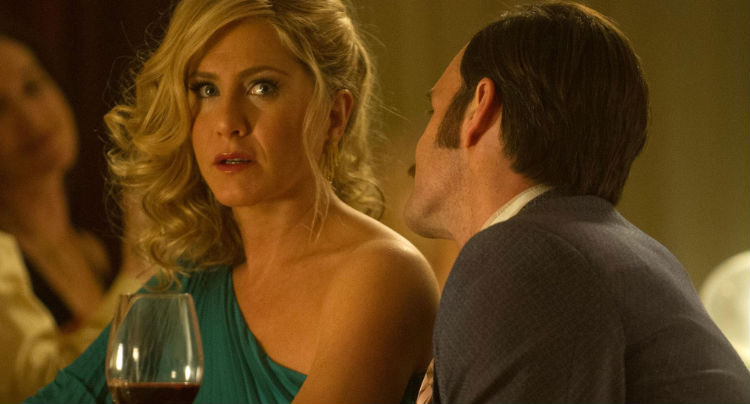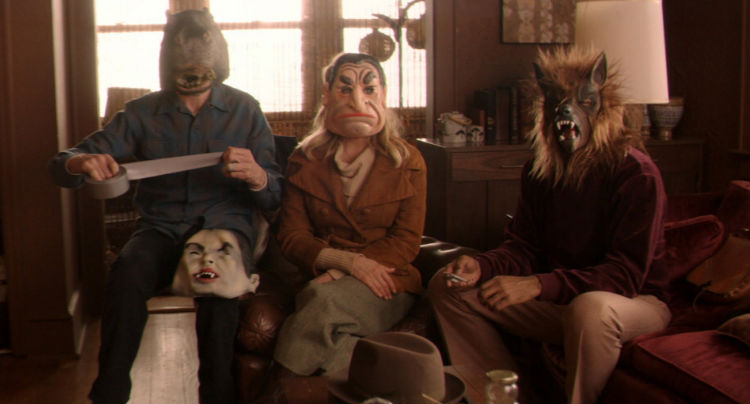
Like a Diet Coke version of a classic Elmore Leonard romp.

Like a Diet Coke version of a classic Elmore Leonard romp.
A particularly muted Elmore Leonard adaptation, Daniel Schechter‘s Life of Crime has real value in its cast and their skillful performances, but the remaining elements of the film, while not disastrous, lack focus and flair, eliciting half-hearted shrugs and soft laughs. It’s like a Diet Coke version of a classic Leonard romp: While Out of Sight and Jackie Brown crackled and popped, Life of Crime (based on “The Switch”) lightly fizzles and lacks the same big flavor. It’s tasty enough, but it’ll make you long for the real stuff.
We meet two small-time crooks in 1978 Detroit named Louis and Ordell (played by John Hawkes and Yasiin Bey, respectively). In their first kidnapping job, they target Mickey Dawson (Jennifer Aniston), the wife of country club blowhard Frank Taylor (Tim Robbins). Frank’s been doing illegal funny business on the side for a while (involving an off-shore bank account and other big-wig nonsense), knowledge of which Louis and Ordell use as leverage to up the pressure. One million dollars is the ransom, but as it turns out, Mickey isn’t worth a million dollars to Frank at all, since she and her drunk, boorish husband positively despise each other. In fact, Frank’s been secretly shacking up with another woman in the Bahamas named Melanie (Isla Fisher), who he plans on marrying. (The divorce papers were in the mail pre-kidnapping.)

Melanie forcefully takes the reigns on Frank’s side of the hostage negotiations, cunningly bending the situation to her whim. Few revelations or genuine surprises arise as the caper unfolds, but there are a few amusing tangles in the plot. Mark Boone Junior plays a burly Nazi nut whose grungy home the crooks use to stash Mickey, but when he’s left alone with her, things get pretty dicey. Will Forte plays a family friend who’s the only witness to Mickey’s kidnapping (he’s got the hots for her, too), but there’s little for him to do in the grand scheme of things.
Mickey develops a sort of friendship with Louis, who she senses is a generally nice guy, despite him being her captor and all. Aniston’s evolution throughout the film–from hapless housewife to thick-skinned tigress–is gratifying to watch. Hawkes and Bey complement each other surprisingly well (though Robert DeNiro and Samuel L. Jackson’s interpretations of the same characters in Jackie Brown are pretty untouchable), and Hawkes enjoys even better chemistry with Aniston. Robbins and Aniston have fun slinging venom, but there’s little drama at the bottom of it all.
Characters swap positions, deceive one another, and the sprawling plot spirals into a controlled chaos (as many Leonard capers do). The way the film wraps up, however, is so meek and uneventful that it’s hard not to feel disappointed. The labyrinthine events that lead us there aren’t anything to get excited about either. Most moments of tension feel way less tense than they’re supposed to, and most chats shared between the quippy characters are thin and soulless. The film just feels so…flimsy.
As far as set design, the period elements are so inconsistent I often forgot the film takes place in the ’70s. Schechter exhibits skill for sure, but whether or not he was pushing himself to be his best, I couldn’t tell. I don’t think so. He surely had a hand in his actors’ good performances, but there’s a pervading sense that he didn’t impose his style onto the project enough, as if he let the Hollywood stars do their own thing because they know what they’re doing. Check out Supporting Characters if you want to see what he’s really capable of.